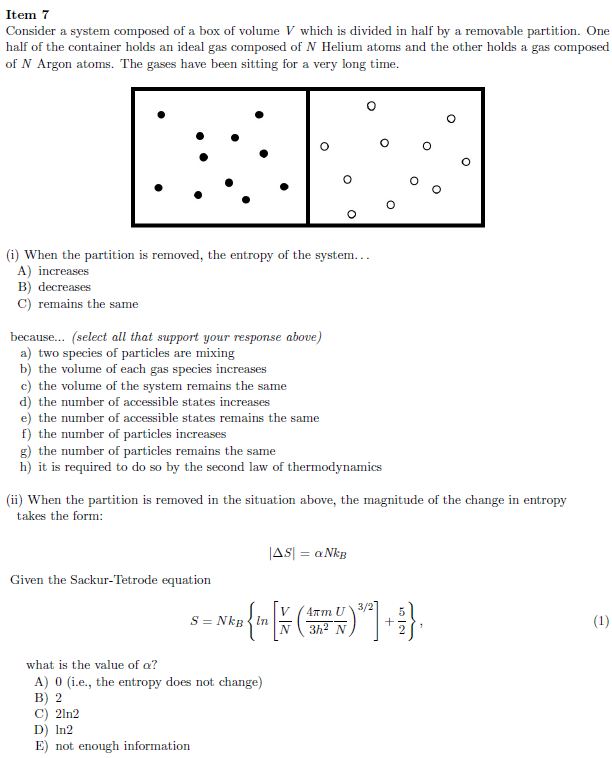Developed by Katherine Rainey, Michael Vignal, Bethany Wilcox
| Purpose | To assess student learning of core content in advanced statistical mechanics and thermodynamics. |
|---|---|
| Format | Multiple-choice, Multiple-response |
| Duration | 50 min |
| Focus | Thermal / Statistical Content knowledge |
| Level | Graduate, Upper-level |

more details
This is the second highest level of research validation, corresponding to at least 5 of the validation categories below.
Research Validation Summary
Based on Research Into:
- Student thinking
Studied Using:
- Student interviews
- Expert review
- Appropriate statistical analysis
Research Conducted:
- At multiple institutions
- By multiple research groups
- Peer-reviewed publication
To ensure that the assessment can be broadly usable, the developers administered a survey to physics faculty to determine the scope and content variability of thermal physics courses across institutions. They received over 70 responses from 63 unique institutions, approximately half of which are minority-serving institutions and women's colleges. They found that there is significant variation in the content covered at different institutions, but also some general agreement on a number of core content areas. They identified 10 key topics which were listed by the majority (95%) of survey respondents to focus on for the assessment development process. They then wrote assessment objectives that encompass core content goals within these 10 topics, which guided the writing of free-response assessment items that were piloted with students. Using student responses to the free-response items, they developed multiple-response versions, which includes both multiple-choice and coupled, multiple-response items. They piloted the U-STEP in multiple classes across various institutions during three semesters, and collected over 600 student responses in total. They used classical test theory to determine item difficulties and discriminations, and differential item functioning to identify potential bias in assessment items that can manifest as performance gaps between different genders and races.
References
- K. Rainey, Upper-Division Thermal Physics Assessment Development and the Impacts of Race & Gender on STEM Participation, University of Colorado Boulder, 2021.
- K. Rainey, M. Vignal, and B. Wilcox, Designing upper-division thermal physics assessment items informed by faculty perspectives of key content coverage, Phys. Rev. Phys. Educ. Res. 16 (2), 020113 (2020).
- K. Rainey, M. Vignal, and B. Wilcox, Validation of a coupled, multiple response assessment for upper-division thermal physics, Phys. Rev. Phys. Educ. Res. 18 (2), 020116 (2022).
- K. Rainey and B. Wilcox, Faculty survey on upper-division thermal physics content coverage, presented at the Physics Education Research Conference 2019, Provo, UT, 2019.
We don't have any translations of this assessment yet.
If you know of a translation that we don't have yet, or if you would like to translate this assessment, please contact us!

Login or register to download the answer key and an excel scoring and analysis tool for this assessment.
| Typical Results |
|---|
The historical average score on the U-STEP is 54%. Averages on individual items can be viewed in Rainey, Vignal, and Wilcox 2022. |
The latest version of the U-STEP, released in 2022, is version 1. Version 1 has 15 questions. 6 additional questions were included in preliminary versions piloted in 2020, but not included in the final version.



